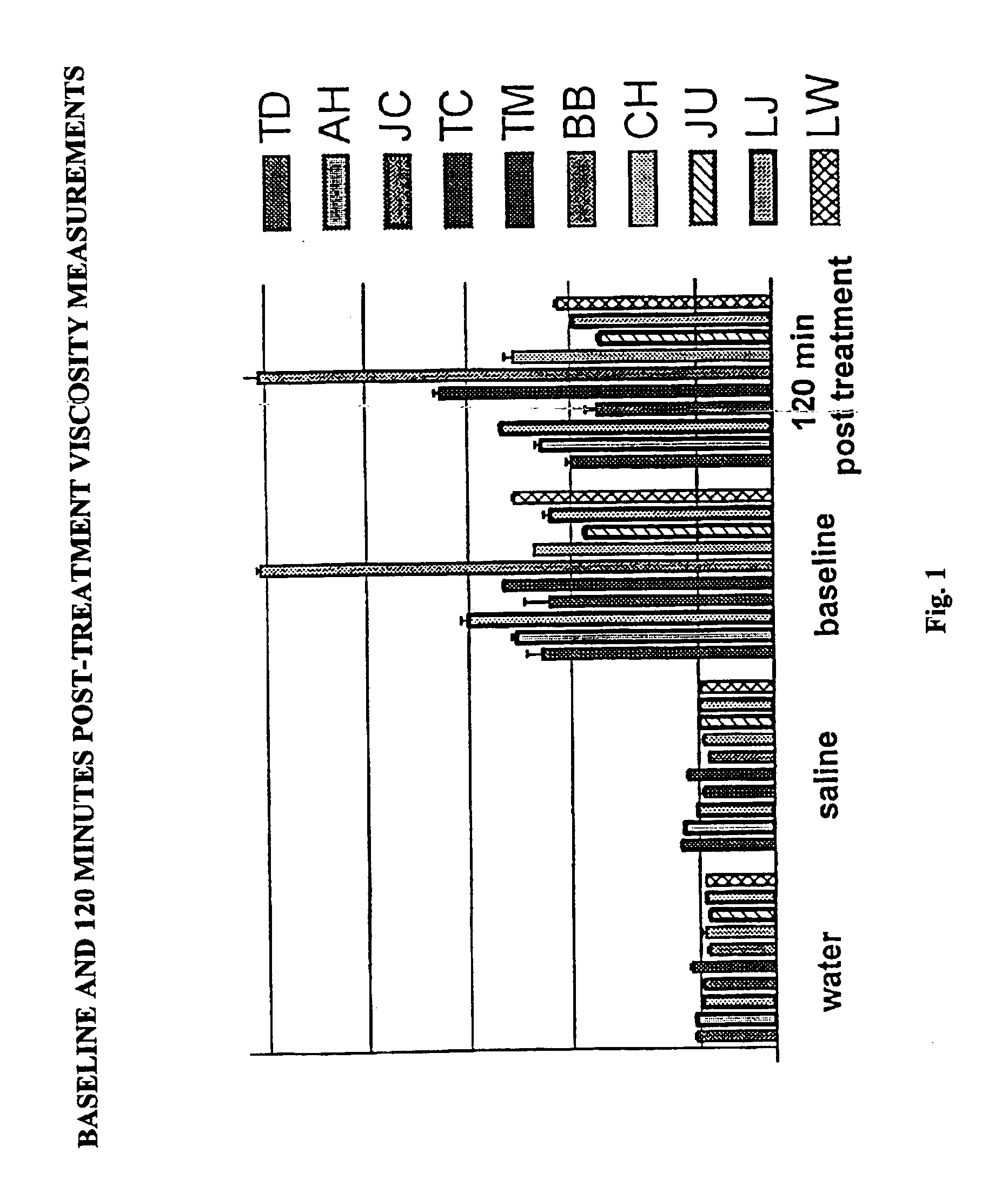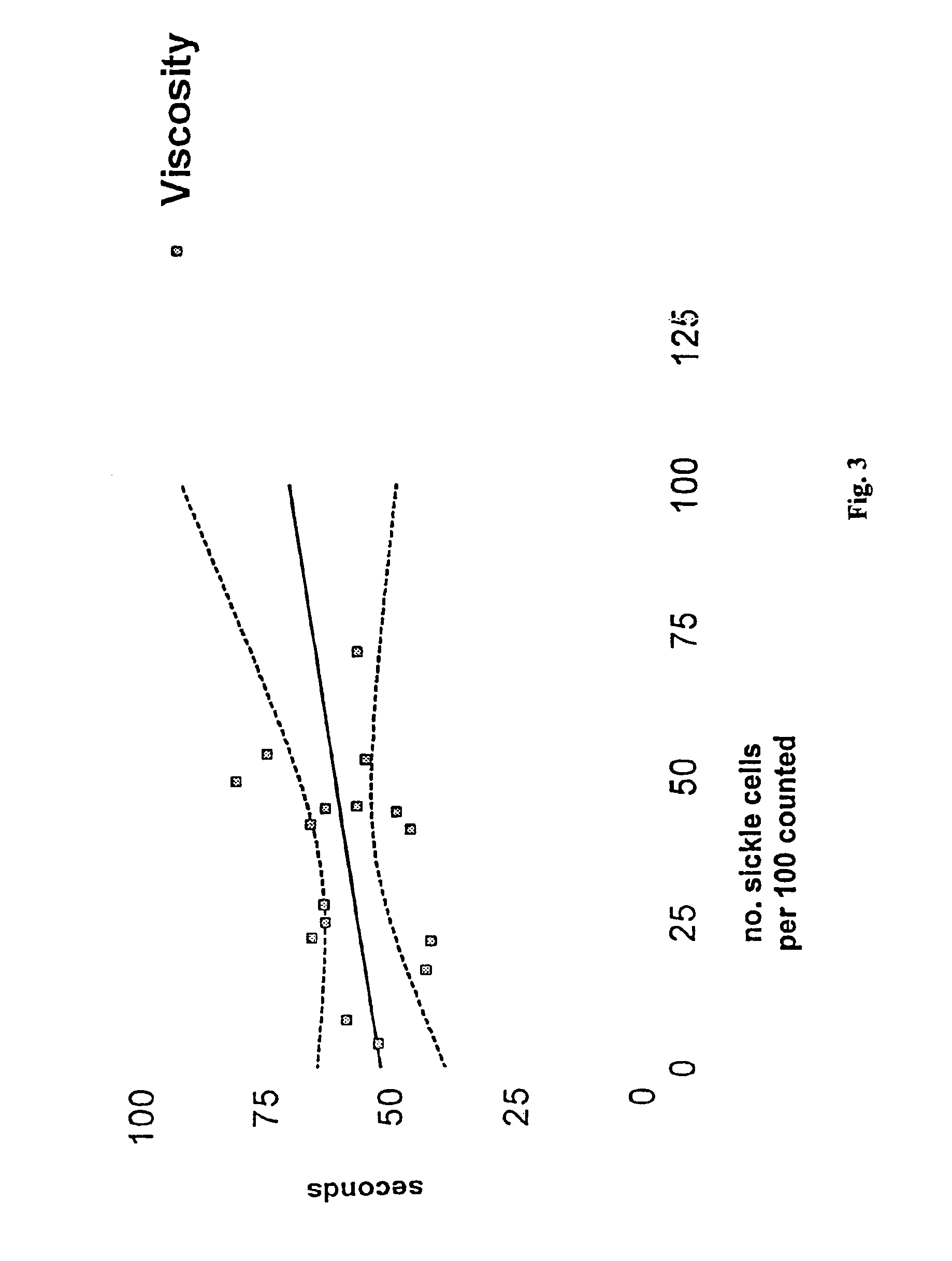Viscosity modulating substance and use thereof
- Summary
- Abstract
- Description
- Claims
- Application Information
AI Technical Summary
Benefits of technology
Problems solved by technology
Method used
Image
Examples
example 1
Viscosity Screening Method for APM Efficacy in Sickle Cell Patients
[0025]The efficacy of APM treatment can be monitored by measuring the viscosity of patient blood samples before and after treatment. Normal blood viscosity increases with increasing hemoglobin concentration. While patients with sickle cell disease are anemic, the viscosity of their blood appears in the abnormal range, and the viscosity increases with an increase in the number of sickle cells relative to the number of normal cells as the anemia is corrected.
[0026]Blood samples were obtained from ten patients having homozygous HgBss disease or heterozygous Hgbsc disease before and after a blinded administration of APM at 1.5 (low dose), 3 (medium dose), or 6 (high dose) milligrams per kilogram body weight. Table I gives the patients'characteristics.
[0027]
TABLE 1Patient CharacteristicsNo.AgeSexDiseaseaHgbHctDosebTD13Mss7.625.4HAH11Fss8.123.3MJC13Msbthal7.525.1LTC9Fsbthal7.925.6HJU4Mss7.922.6MLJ4Mss7.922.6HTM19Fsc10.330....
example 2
Metabisulfite Slide Test to Measure Sickling in Blood Samples In Vitro
[0037]Using the sickling test described herein, the number of sickle cells relative to the number of normal cells can be measured with and without APM treatment.
[0038]Blood was drawn before and 120 minutes after treatment with 0, 1.5, 3, or 6 milligrams APM per kilogram body weight in a blinded fashion from the ten patients into heparin tubes, stored in a refrigerator at approximately 10° C. and routinely tested within 36 hours of collection.
[0039]Normal blood devoid of abnormal hemoglobin was used as a control. For each heparinized patient blood sample and the normal blood control, experimental samples were prepared containing 0.25 milliliters of normal saline and 0.25 milliliters of blood.
[0040]Using metabisulfite to reduce HbS to the deoxy form (Daland, G. A. and Castle, W. B. 1948. J Lab Clin Med 33:1082-1088; Nelson, D. A. In Todd-Sanford-Davidsohn Clinical Diagnosis by Laboratory Methods, J. B. Henry, ed. (W...
example 3
Method of Monitoring Therapy in a Multiple Myeloma Patient
[0043]The following method can be used for monitoring the reduction in whole blood viscosity in a patient suffering from multiple myeloma and exhibiting elevated whole blood viscosity upon administration of a composition comprising N-L-alpha-aspartyl-L-phenylalanine 1-methyl ester (APM). A blood sample from the patient is collected prior to treatment with APM. Saline, water, and normal whole blood is used as controls, and viscosity measurements are taken for saline, water, normal whole blood, and the patient blood with and without APM. To perform each viscosity measurement, an aliquot of the test fluid, i.e., water, saline, normal whole blood, or untreated patient blood is drawn into a pipette held stationary in a vertical position, and the time required to expel a drop of the test fluid from the lower end of the pipette is measured, providing a baseline time interval which serves as an indicator of blood viscosity. Preferabl...
PUM
| Property | Measurement | Unit |
|---|---|---|
| Weight | aaaaa | aaaaa |
| Dimensionless property | aaaaa | aaaaa |
| Dimensionless property | aaaaa | aaaaa |
Abstract
Description
Claims
Application Information
 Login to View More
Login to View More - R&D
- Intellectual Property
- Life Sciences
- Materials
- Tech Scout
- Unparalleled Data Quality
- Higher Quality Content
- 60% Fewer Hallucinations
Browse by: Latest US Patents, China's latest patents, Technical Efficacy Thesaurus, Application Domain, Technology Topic, Popular Technical Reports.
© 2025 PatSnap. All rights reserved.Legal|Privacy policy|Modern Slavery Act Transparency Statement|Sitemap|About US| Contact US: help@patsnap.com



